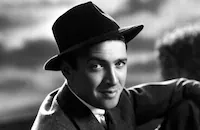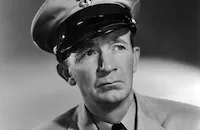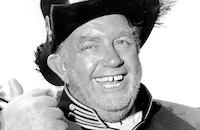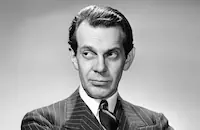How the West Was Won

Brief Synopsis
Cast & Crew
Spencer Tracy
Carroll Baker
Lee J. Cobb
Henry Fonda
Carolyn Jones
Karl Malden
Film Details
Technical Specs

Synopsis
A 5-part saga beginning with THE RIVERS: In 1829, Zebulon Prescott takes his wife Rebecca and their two young sons and two daughters away from their New England farm and heads west on a raft down the Ohio River to seek new opportunities and find husbands for the girls, Eve and Lil. One night a stranger in a canoe approaches the family's campsite; at first they suspect him of being a river pirate, but he turns out to be congenial fur trapper Linus Rawlings, who impresses the Prescott boys with tall tales of legendary mountain man Jim Bridger. Eve is also taken with Linus, but the noncommittal backwoodsman leaves abruptly one morning. Linus interrupts his journey to stop at a tavern-general store operated in a cave by river pirate Colonel Hawkins, whose alluring young daughter, Dora, clubs Linus on the head and throws him into a pit in the back of the cave. Soon the Prescotts happen by and are in the midst of being robbed by the murderous Hawkins clan when Linus, who has swum outside to the river through an opening in the pit, sneaks up behind the thieves and saves the settlers with the help of some explosives. As the Prescotts continue their journey by raft, they are swept away by rapids; Zebulon and Rebecca drown; and Linus, having seen Eve survive danger twice, decides at the funeral to marry her and settle by her parents' gravesite. Lil, meanwhile, decides to go to St. Louis. THE PLAINS: Gambler Cleve Van Valen and his cronies watch Lil Prescott's dance hall act and make a wager as to how many petticoats she is wearing. Cleve goes backstage to her dressing room to obtain firsthand proof and overhears that Lil has just inherited a gold mine in California from an elderly admirer. Heavily in debt, Cleve decides to follow Lil out West in hopes of obtaining some of her revenue; along the way she falls in love with him and refuses the marriage proposal of wagon master Roger Morgan. After surviving an Indian attack, Lil and Cleve arrive in California, only to learn that the mine is worthless. The news temporarily halts Cleve's courtship, but they eventually marry after all and decide to settle in the new boomtown of San Francisco. THE CIVIL WAR: Eve, who has lost Linus to battle, watches their son, Zeb, leave home to join the Union Army. Once in combat, Zeb finds that war is not as glorious as he was led to believe, and at the Battle of Shiloh he meets a Confederate deserter who is similarly disillusioned. Together they witness an intimate conversation between Generals Sherman and Grant, in which the latter expresses concern about public criticism of his drinking. The Confederate soldier suddenly tries to assassinate the generals, and Zeb is forced to kill his new friend. After the war, he returns home to find that his mother has died; he joins the U. S. Cavalry to protect railroad workers from the Indians. THE RAILROAD: Aided by Jethro Stuart, a grizzled buffalo hunter, Zeb manages to keep peace with the Indians until ruthless foreman Mike King demands that the railroad break a treaty and take a shortcut through Indian land. Consequently, the Indians stampede the buffalo, and the animals destroy the camp, leaving several children orphaned. Angered that he has unwittingly been involved in the tragedy, Zeb resigns and goes to Arizona. THE OUTLAWS: Now a marshal in the 1880's, Zeb, his wife, Julie, and their children are visited by Lil, widowed and somewhat impoverished after a life of intermittent luxury with Cleve. Meanwhile, Zeb learns that an old enemy, Charlie Gant, is planning with his gang to rob a train carrying a gold shipment. Julie begs him not to go after Gant, but Zeb, who is anxious to send the outlaw to jail, is adamant. A furious gunfight takes place on the runaway train, during which the chains on the log car break and scatter logs across the countryside. Zeb barely escapes death, and the entire train derails, but Zeb nevertheless slays his adversary and returns to his family.

Cast

Spencer Tracy

Carroll Baker

Lee J. Cobb

Henry Fonda

Carolyn Jones

Karl Malden

Gregory Peck

George Peppard

Robert Preston

Harry Morgan

Debbie Reynolds

James Stewart

Eli Wallach

John Wayne

Richard Widmark

Brigid Bazlen

Walter Brennan

David Brian

Andy Devine

Raymond Massey

Agnes Moorehead

Thelma Ritter

Mickey Shaughnessy

Russ Tamblyn
Tudor Owen
Barry Harvey
Jamie Ross

Willis Bouchey
Kimm Charney

Bryan Russell
Claude Johnson
Jerry Holmes
Rudolph Acosta
Chief Weasel
Red Cloud
Ben Black Elk
Mark Allen

Lee Van Cleef
Charles Briggs

Jay C. Flippen

Clinton Sundberg

James Griffith
Walter Burke

Joe Sawyer
John Larch
Jack Pennick
Craig Duncan
Crew
Fred Bosch
Sammy Cahn
Thomas Conroy
William H. Daniels
Ken Darby
Ken Darby
George W. Davis
Robert Emmett Dolan
William Ferrari
John Ford
A. Arnold Gillespie
Henry Grace
Don Greenwood Jr.
Sydney Guilaroff
Charles K. Hagedon
Henry Hathaway
Addison Hehr
Robert R. Hoag
Milton Krasner
Harold F. Kress
Charles Lang Jr.
Joseph Lashelle
George Marshall
William Mcgarry
Johnny Mercer
Jack Mills
Franklin Milton
Alfred Newman
Alfred Newman
Walter Plunkett
Robert Saunders
William Shanks
Ray Sharples
Bernard Smith
Wingate Smith
William Tuttle
James R. Webb
Harold E. Wellman

Photo Collections
Videos
Movie Clip





Trailer
Hosted Intro






Film Details
Technical Specs

Award Wins
Best Editing
Best Sound
Best Writing, Screenplay
Award Nominations
Best Art Direction
Best Cinematography
Best Costume Design
Best Picture
Best Score
Articles
How the West Was Won
The amazing thing about all that effort is that How the West Was Won focuses on the human element, never losing the story or interest in all the activity. The film follows four generations of one family through the development of the West, starting in 1839 with a journey through the Erie Canal and then towards the frontier. Other segments show the family as they try to establish a home, get caught in the Civil War, witness the westward expansion of the railroad and encounter outlaws. The film is both a tribute and a reminder of those vanished times and its populated by mountain men, the US Cavalry, gamblers, sheriffs, farmers, soldiers, Native Americans and buffalo herds.
Naturally How the West Was Won was a major undertaking for MGM who turned much of their resources to its production. The studio spent the huge sum of $15 million during a shoot that lasted about a year. The mammoth production was entrusted to three directors. John Ford, fresh from The Man Who Shot Liberty Valance (1958), did the Civil War episode while George Marshall (The Sheepman, 1958) did the railroad segment. The other major sections (concerning the river, the plains and the outlaws) were done by Henry Hathaway (Kiss of Death (1947) and later True Grit, 1969). A fourth director, Richard Thorpe, did the brief connecting segments without credit.
One thing you might notice about the film is that sometimes there are barely visible lines dividing the image into thirds. That's because How the West Was Won was the first feature film shot in the Cinerama process. This was a massive widescreen process that required three separate cameras side by side to record the action. In a theatre three projectors were used to show the images on a special curved screen, resulting in a vast widescreen experience wider than the usual Cinemascope. Those lines result from the three separate images matching up though they're rarely distracting and the clever cinematographers often hid them in the image of a tree or pole. You can see the commercial problems with this process, though, and it's not surprising that Cinerama never really caught on.
Clearly plenty of actors were needed for such a story, resulting in major stars appearing in brief cameos. John Wayne appears as General Sherman, a character he previously impersonated on an episode of TV's Wagon Train. Jimmy Stewart plays a man twenty years younger than he actually was. Henry Fonda's character was originally much more prominent but revisions trimmed it down. He was lucky since Hope Lange, who played his character's daughter and George Peppard's girlfriend, had her entire part cut. Spencer Tracy does the voice-over narration. The actor-spotters will be delighted to catch early roles by Lee Van Cleef, Harry Dean Stanton, Russ Tamblyn, Jay C. Flippen and veteran stuntman Gil Perkins (who'd worked on King Kong (1933) and Captains Courageous, 1937). And for a dab of authenticity, one of the Indian actors had actually participated in the battle at Little Big Horn.
Alex North's score was also nominated for an Oscar. He based some of his themes on authentic folk material and had originally planned on using the Kingston Trio for the film's songs. However, after seeing a new group featuring former Trio member Dave Guard and cult musician Judy Henske, he decided to go with them instead. It took over 18 months to get all the music recorded, using the folk group as well as a 75-piece orchestra. A soundtrack CD with much of the music and some previously unheard cues is available.
(By the way, there's an urban legend that a stuntman was killed while making this film. It's not true though stuntman Bob Morgan, Yvonne De Carlo's husband, did lose a leg in a serious accident with fiberglass logs on the train; however it was not during actual filming.)
Producer: Bernard Smith
Director: John Ford; Henry Hathaway; George Marshall; Richard Thorpe
Screenplay: James R. Webb
Set Design: Henry W. Grace; Don Greenwood, Jr.; Jack Mills
Cinematography: William H. Daniels; Milton Krasner; Charles B. Lang; Joseph LaShelle; Harold E. Wellamn
Costume Design: Walter Plunkett
Film Editing: Harold Kress
Original Music: Ken Darby; Alfred Newman
Principal Cast: James Stewart (Linus Rawlings), Carroll Baker (Eve Prescott), Henry Fonda (Jethro Stuart), Lee J. Cobb (Marshal Lou Ramsey), Gregory Peck (Cleve Van Valen), Debbie Reynolds (Lilith Prescott), Carolyn Jones (Julie Rawlings), George Peppard (Zeb Rawlings), Karl Malden (Zebulon Prescott).
C-165m. Letterboxed. Closed captioning. Descriptive Video.
by Lang Thompson

How the West Was Won
How the West Was Won - The Restored Version of HOW THE WEST WAS WON on DVD
How the West Was Won tells five separate stories involving various members of a pioneer family, starting in the 1830s and ending fifty years later. The first episode shows the Prescott clan rafting west on a river, encountering tragedy when two members of the family drown, and finding hope when a friendly mountain man (James Stewart) falls in love with one of the pretty daughters (Carroll Baker) and later marries her. In the second part, the other daughter (Debbie Reynolds) is a riverboat singer being courted by two men (Gregory Peck, Robert Preston) with very different personalities. The third episode centers on a shaky young Civil War soldier (George Peppard) who crosses the paths of two famous generals (John Wayne, Henry [Harry] Morgan) and foils an assassination. In the fourth chapter, two railroad companies have a war that sets a buffalo hunter (Henry Fonda) against a greedy capitalist (Richard Widmark) who causes bloodshed by cheating the Arapahos who live where he wants to build, and in the last segment a marshal (Lee J. Cobb) helps to ambush a crazy outlaw (Eli Wallach) who's setting up a great train robbery. Suggested by an eponymous series of Life magazine articles, the picture earned James R. Webb an Academy Award for best original screenplay. Out of seven other nominations, Oscars also went to the film editing and sound.
Until the premiere of How the West Was Won in early 1962, documentaries had filled Cinerama's release slate ever since its 1952 debut attraction, This Is Cinerama, wowed movie fans with a Spanish bullfight, water-splashed views of Niagara Falls, and other imposing sights, including a roller-coaster ride that had patrons reeling in their seats. After four more nonfiction films, Cinerama broadened its horizons by striking a deal with MGM for two narrative movies that would exploit the special properties of the curved 146-degree screen and seven-speaker stereophonic sound; the other MGM coproduction was The Wonderful World of the Brothers Grimm, shot simultaneously but released six months after the western epic. These were the last two pictures (and the only narrative films) shot in the classical three-strip Cinerama process, which was replaced by 65-mm and 70mm formats for subsequent Cinerama films ranging from It's a Mad, Mad, Mad, Mad World in 1963 to 2001: A Space Odyssey in 1968.
How the West Was Won comes across today as a distinctly old-fashioned western low in bloodshed, moderate in action, high in eye-catching scenery. Knowing that many Cinerama patrons brought their children along, the producers kept gunplay to a minimum and eliminated a subplot about a pregnant woman who leaves home to be a single mom, even though this last-minute change meant that part of the railroad episode, filmed by Marshall on location, had to be reshot by Hathaway on a soundstage. The picture's best action sequences are still pretty exciting, though, and they're extra impressive when you remember the massive size and weight of the Cinerama camera, which was really a set of three synchronized cameras side by side, each shooting its own strip of film. Among its other disadvantages, this apparatus gives enormous depth of field, with everything in focus no matter how near or far away it is; so if an intimate outdoor scene takes place without a visual barrier behind it, acres of background have to be groomed as carefully as the actors in the foreground.
Speaking of intimate scenes, Cinerama places particular demands on dramatic acting. Due to the camera's unique optical properties, a Cinerama close-up can't be very close a waist-up view is the best the format can manage and the device's fixed lenses mean the whole gizmo has to be moved every time a new vantage point is needed. On top of all this, the lenses point in slightly different directions, so unless the players are occupying the same segment of the screen, they have to gaze not at each other but past each other to look like they're interacting face to face. This is why Cinerama directors often group key characters in the center panel of the screen, leaving the side panels to scenery and extras. Another common trick is to set up the camera so that vertical objects (trees, pillars, etc.) are located on the left and right sides of the center panel; when the three film strips are projected from three different booths in the theater, these objects hide the vertical join-lines where the three pictures come together on the screen. It's little wonder that an old Hollywood hand like Ford quickly lost patience with the ungainly process. He'd been sitting right next to the camera for almost fifty years, but if he did it now he'd block part of a lens and end up in the shot! The somber Civil War episode of How the West Was Won marked his first and last Cinerama experience.
Warner Home Video's edition of How the West Was Won is packaged with first-rate DVD extras including the feature-length documentary Cinerama Adventure, about the history of the format, and a lively commentary track featuring film historian Rudy Behlmer and film-music expert John Burlingame along with Cinerama chief John Sittig, documentary director David Strohmaier, and stuntperson Loren James, who took a daunting number of falls, tumbles, and spills in the picture without meeting the fate of his colleague Bob Morgan, who was permanently maimed when a stunt went wrong during the train-robbery scene. (Morgan himself talks about this in Cinerama Adventure, but the commentary track is inexplicably silent about it.) In addition to the challenges it posed to filmmakers and performers, however, Cinerama presents interesting tests for DVD producers. The commentary track keeps claiming that high-tech video processing has erased the join-lines from the wide-screen image, but they're plain to see in many parts of the film. And there's no way a home-video system can reproduce the impact of the super-huge and ultra-curved Cinerama screen. The original aspect ratio (about 2.89:1, although accounts vary) comes out like a ribbon, and even the most sophisticated flat-screen TV is, well, flat.
This said, How the West Was Won is a very colorful ribbon, and while the adventure doesn't exactly jump from the screen, it offers a fair amount of traditional western excitement along with creaky ingredients that have old-Hollywood charms of their own. IMAX has won the war of the wide screens, but Cinerama still lingers on the sidelines, and even the DVD version provides a hint of what all the excitement was about.
For more information about How the West Was Won, visit Warner Video. To order How the West Was Won, go to TCM Shopping.
by David Sterritt
How the West Was Won - The Restored Version of HOW THE WEST WAS WON on DVD
Quotes
O Lord, without consulting with Thee, we have sent thy way some souls whose evil ways passeth all understanding. We ask Thee humbly to receive them...whether you want them or not! Amen.- Zebulon Prescott
Why did you bring those bodies here?- Mike King
They're railroaders. I thought somebody in the railroad might be interested.- Jethro Stuart
I'm the railroad and I'm not interested!- Mike King
Trivia
Some stock footage from other (non-Cinerama) epics were used. The Mexican army marching past the Alamo came from Alamo, The (1960) and a civil war battle was taken from Raintree County (1957). The final scenes of the modern U.S. were from This Is Cinerama (1952).
No ordinary CinemaScope version was filmed simultaneously with the Cinerama version, resulting in two ugly dividing lines on the non-Cinerama theater prints, video, TV, and DVD versions (indicating the three synchronized film strips originally used).
The first non-documentary Cinerama film, it was also one of the last to use the old three-camera technique, resulting in two very visible, somewhat distracting, dividing lines in the non-Cinerama print and all TV and home video versions.
Hope Lange was cast as a love interest for George Peppard's character, but her scenes were cut from the final print of the film.
A comic book version of "How The West Was Won" was released in conjunction with the film's release, as was the practice back then with all family and children's films.
Notes
Location scenes filmed at Battery Rock along the Ohio River in Illinois; Courthouse Mountain in the Pinnacles National Monument, California; Chimney Rock in the Colorado Rockies; Monument Valley on the Arizona-Utah border; the countryside around Paducah, Kentucky; Custer State Park, South Dakota; and in Uncompaghre (Colorado), Tonto (Arizona) and Inyo (California-Nevada) National Forests. Opened in London November 1, 1962. Also reviewed at 162 and 165 min; copyright length: 149 min. The final scene in the Cinerama version, a panoramic helicopter view of modern-day America, was omitted from the film in its general release version. The non-roadshow version was released in 35mm CinemaScope.

Miscellaneous Notes
Shown at Seattle International Film Festival (Cinerama Day) May 18 - June 11, 2000.
Selected in 1997 for inclusion in the Library of Congress' National Film Registry.
Released in United States Winter December 31, 1962
Released in United States March 1980 (Shown at FILMEX: Los Angeles International Film Exposition (The Epic: A Monumental Movie Marathon) March 4-21, 1980.)
Released in United States Winter December 31, 1962
Released in United States February 20, 1963
Released in United States March 1980
Released in United States 2000
Released in United States February 20, 1963
Released in United States 2000 (Shown at Seattle International Film Festival (Cinerama Day) May 18 - June 11, 2000.)
Voted One of the Year's Ten Best Films by the 1963 National Board of Review.














